I lived in Japan for two and a half years and have visited three times since then, most recently in February/March 2019. When I say I love Japanese food, in reality I like roughly 5%, albeit that I like that 5% a lot. I love the idea of Japanese food in that the emphasis is on seasonal, good quality, fresh produce and using up as much of the meat, vegetable, fish, etc, as possible. It is just unfortunate that a lot of elements (fermentation, abundance of fish usage, enthusiasm for raw non-vegetables and unfamiliar textures) are not at all to my taste.
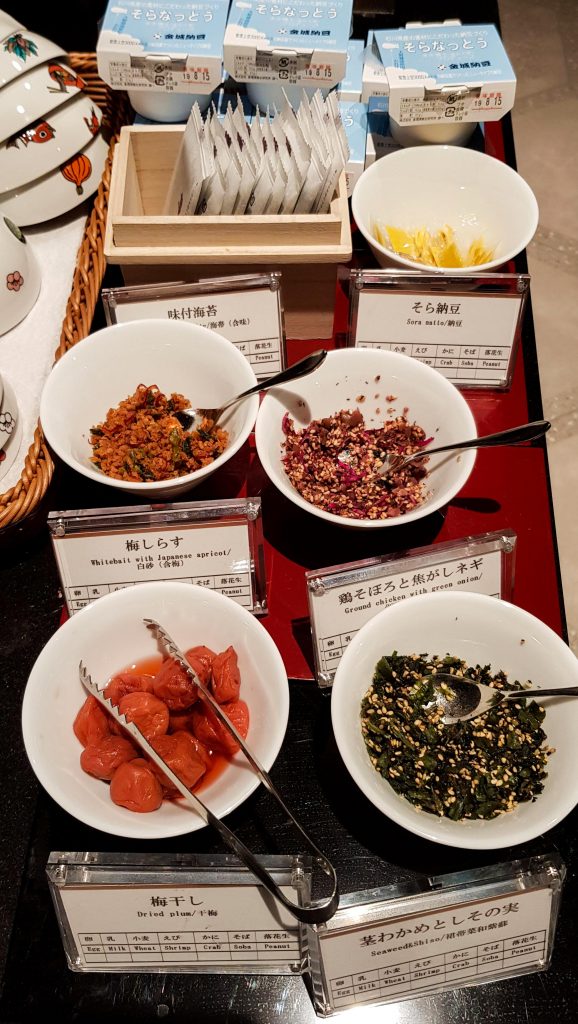
However, there are plenty of dishes to enjoy, in part because they are vaguely similar to British/Western food or they are now more mainstream in the UK than Japanese food ever was when I first went to Japan in 1998. If you are an adventurous eater while overseas, Japan is an ideal place to try new flavours and ingredients and you probably wouldn’t have any interest in a list like this. If you are vegetarian, I could not vouch for any of these dishes being available as fully vegetarian unless specified in a restaurant, though the deep-fried vegetable and burdock salad options should be vegetarian. A lot of stock, also miso soup, is fish-based, even though it is not always apparent from the menu.
In no particular order:
Onigiri. Not a restaurant dish but all the ubiquitous convenience stores (7/11, Lawson, Family Mart) sell triangles of onigiri, which nowadays have the contents written in English on the outside to save a veritable Russian roulette whereby unfamiliar, and often as a result unpalatable, fillings can be avoided. If you follow the three-step unwrapping guide on each pack, you will end up with, from inside out, a filling (for me it’s all about the tuna mayonnaise), a triangle of rice and a cover of seaweed (first bite crispy, the rest unexpectedly satisfyingly chewy). If you opt for the “ume” (“oo-may”, plum), it will probably be salted and a face-pucker-upper if you’re not used to the sour/salty/sweet taste. If you decide the roulette option is worth a try, don’t, just don’t, choose the “natto” filling. I could write an entire blog post just about the food hell that is natto. Each onigiri will cost around 130 yen and they make a fabulous lunch or snack. For maybe ¥200, freshly made onigiri from a specific onigiri shop (Kanazawa station has an amazing onigiri kitchen) are even more tasty and well worth seeking out.
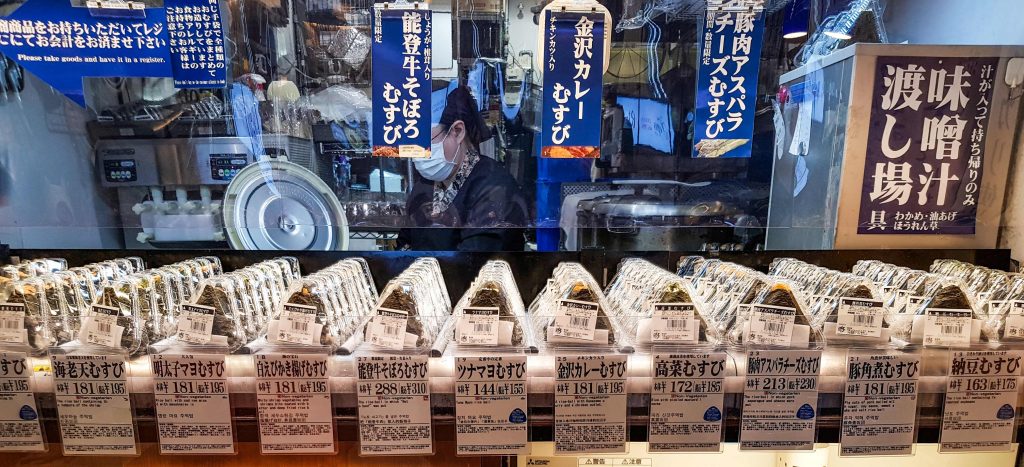
Onigiri at Kanazawa station 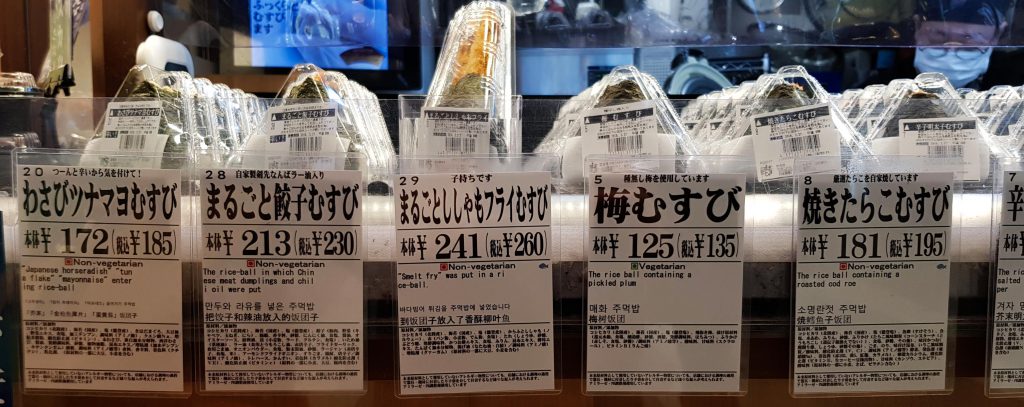
Onigiri at Kanazawa station
Yakiniku. Yaki means grilled, niku means meat. You’re in a bit of trouble if you choose a yakiniku restaurant with no English as it’s all about choosing the cut of beef (there is occasionally another kind of meat but, really, it’s all about the beef) and cooking it yourself at your table, then dipping in amazing sauces; menu pictures are usually just slices of raw beef, which to a non-butcher look like … well, raw beef. The cooked end result with dipping sauce tastes great if you like beef, and tongue, something that horrified me when Japanese friends ordered it, is a delicious cut to choose.
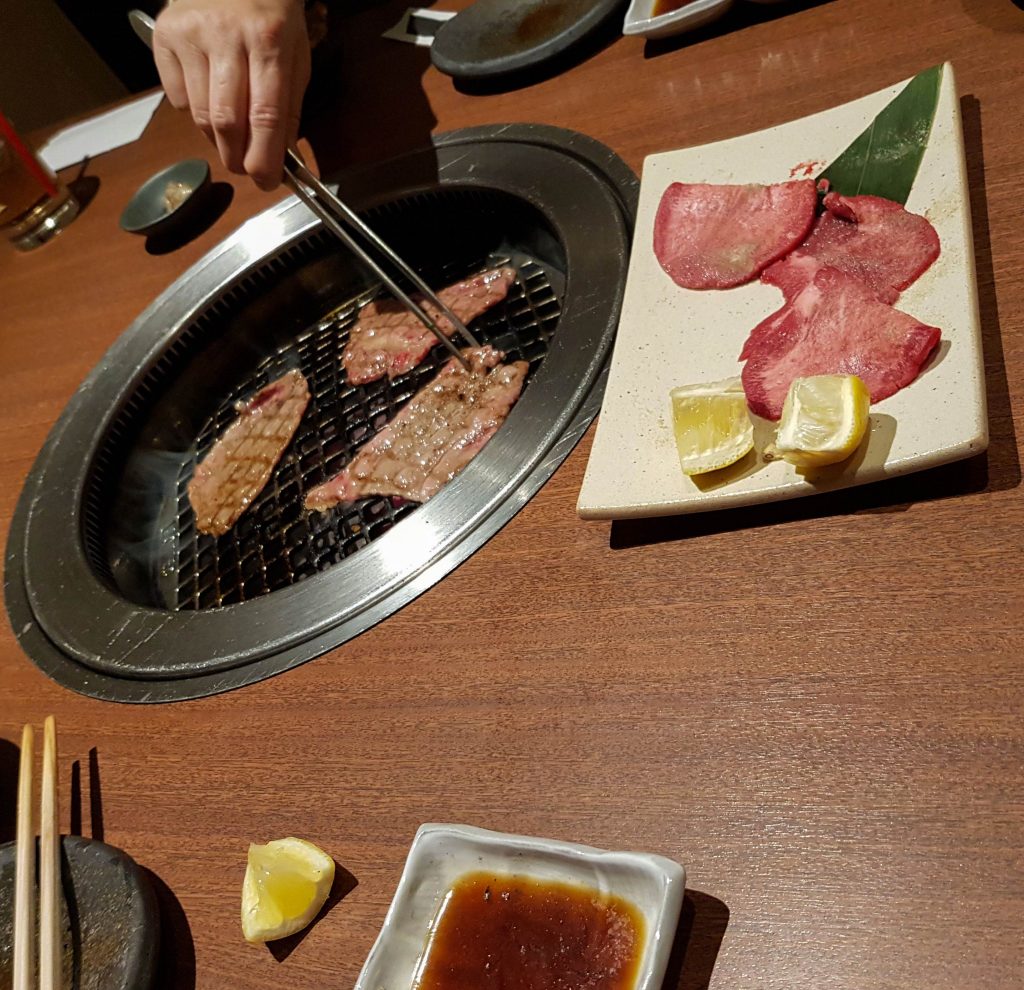
Hormone-free Japanese beef ready to be cooked at our table and dipped in sauce. Kofujin, Nara Prefecture 
Cooking tongue at our table’s grill. Kofujin, Nara Prefecture
Okonomiyaki. Cooked, as above, in front of you on your table’s hot plate (either completely or just to serve). It’s kind of just egg, veg and meat and/or fish and/or noodles. Some people say it’s a Japanese pancake but that’s misleading as there is a lot more to it than your average pancake. Sauces and mayonnaise are optional but try the mayonnaise before expressing disdain. The brown sauces are quite sweet and, frankly, delicious, and are squeezed in pretty zigzags across the top. Okonomiyaki is usually sprinkled with what looks like very thin, wriggling wood shavings; they are flakes of dried fish, which do add a slightly fishy taste that works well unless you 100% hate fish.
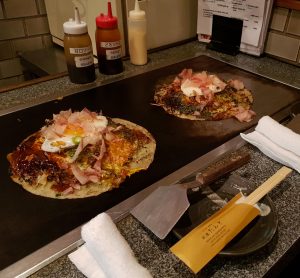
Shabu shabu and sukiyaki. Both are hot pots of broth with various vegetables, mushrooms, meat, fish and/or tofu added and are usually shared. Shabu shabu often comes with a ponzu dip (I love it – soy sauce with yuzu, a very distinctive citrus fruit whose smell I could inhale all day). A sesame dip, goma dare, is also particularly good, “goma” being Japanese for sesame.
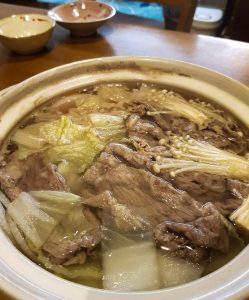
Curryrice. Not curry as you know it. The likelihood is the brown sauce will be sweeter than you expect, there will possibly only be one chunk of meat and there may be rogue vegetables you don’t expect but struggle to identify due to the thick, brown sauce. It is an experience rather than an Indian or British-style curry with familiar long grain rice and a chilli kick. Curryrice has an interesting history if you are in the mood for a Google search. Turns out the British invented it for the Japanese navy. Long story. You will see boxes and boxes of curryrice for sale in supermarkets. It would be wrong to write “curry rice”, it really is curryrice.
Omurice. Rice inside an omelette. Obvs. Often with a tomato ketchup face squirted on top. As above, an experience rather than a delicacy, which comes under the category of foreign food in Japan, a concept which amazes me given that I have never seen ketchup-covered omelette wrapped around rice anywhere outside Japan other than perhaps in a child’s imagination.
Tempura. Deep-fried prawn (ebi), vegetables (sweet potato, pumpkin and aubergine are my favourites) in a very light bubbly batter. Delicious. Usually served with a thin, light, vinegary dipping sauce, which suits the fried taste of tempura.
Udon. Thick noodles, I mean really thick. Usually served in a mild, light broth with meat, tofu and/or vegetables. Tasty, but if you don’t like doughy things or very fat pasta these might be a noodle to avoid.

Ramen. Basically, noodle soup with vegetables, meat, fish and/or tofu. The pretty bright pink and white flower-like slices you sometimes see are fish paste. It can be a bit overwhelming at a ramen restaurant as there are lots of different kinds of broths and styles, eg miso, soy, pork (tonkotsu), shellfish.
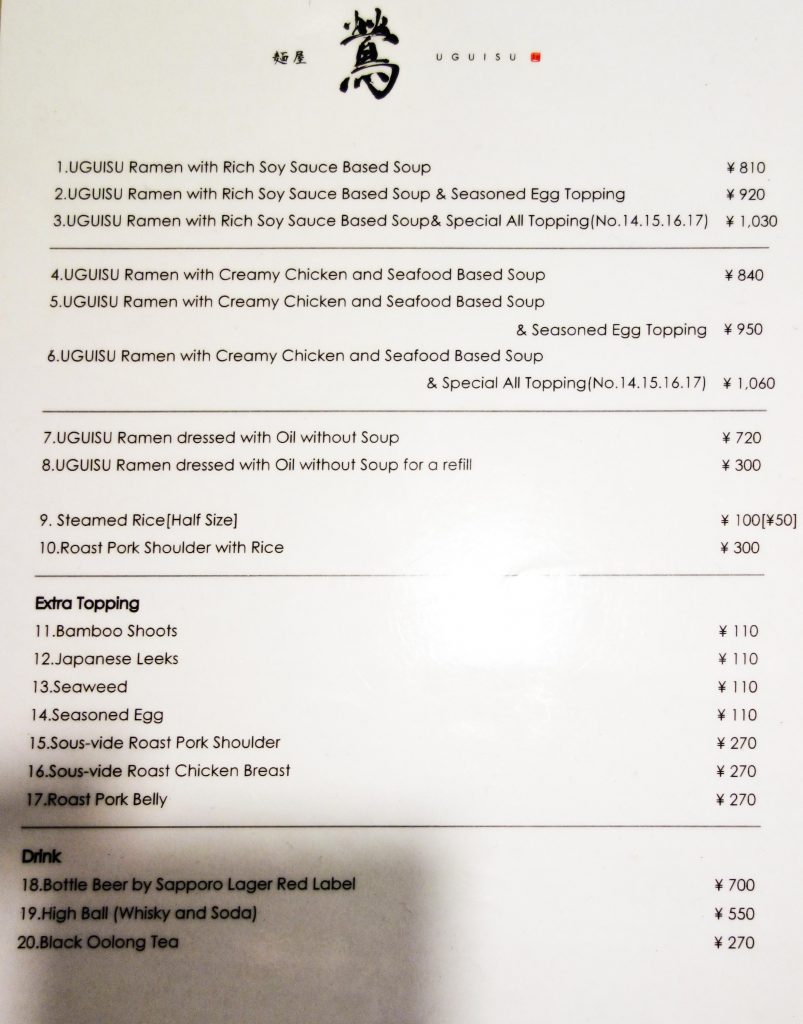
Uguisu, Kanazawa ramen menu 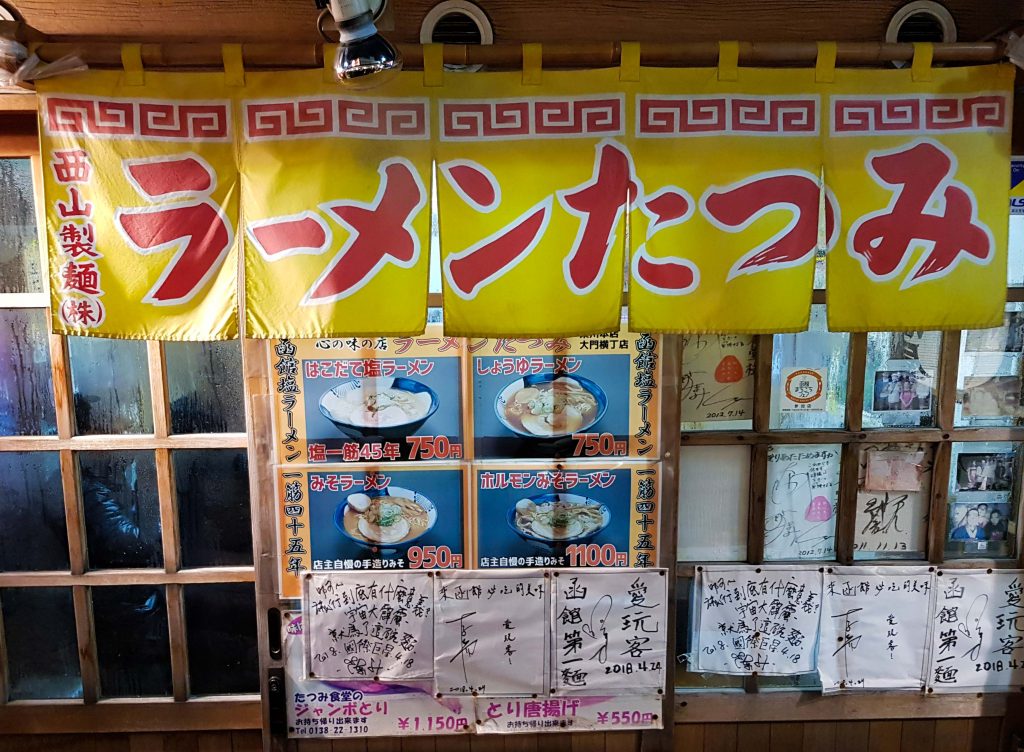
Ramen bar Tatsumi without any English, Hakodate, Hokkaido 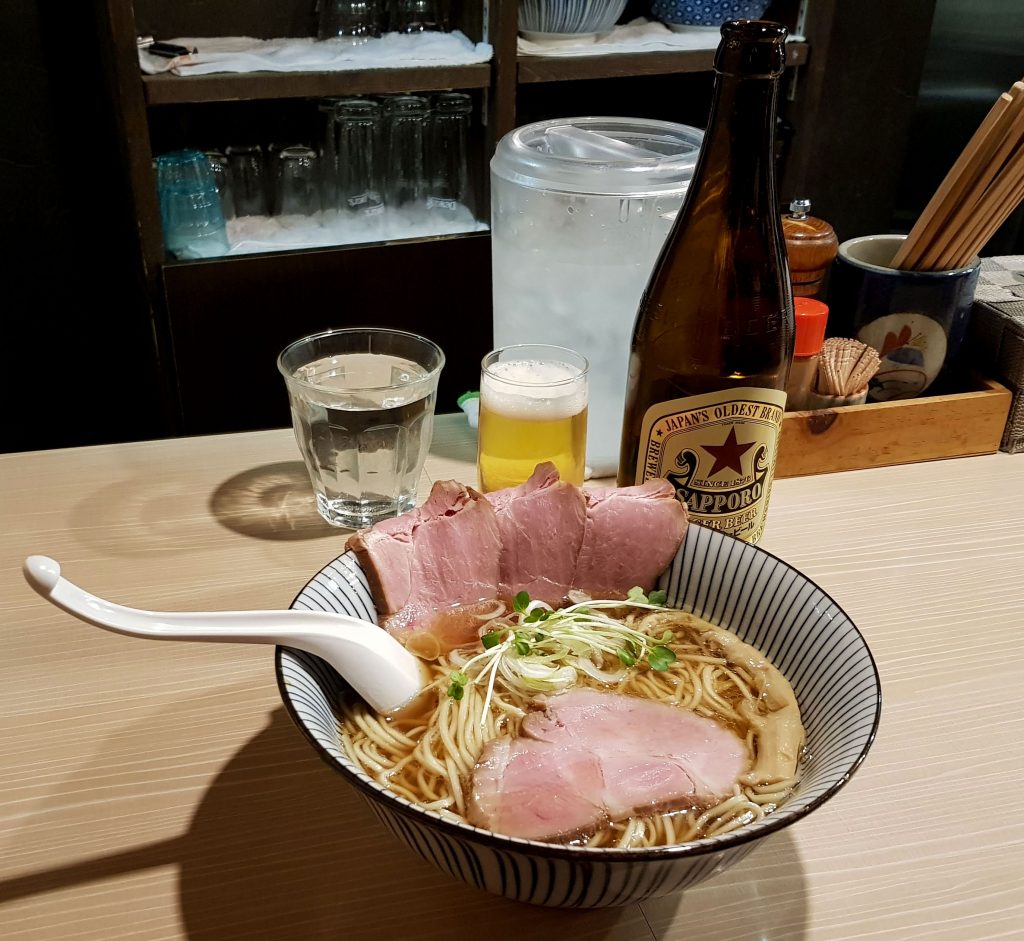
Uguisu, Kanazawa . My favourite ramen diner EVER
Yakitori. “Tori” is chicken. These are small skewers of chicken, some with spring onion too (“torinegi”). But beware, more parts of a chicken than your average Brit deems edible are made into yakitori skewers. Gizzard, chicken tail and heart are amongst them.
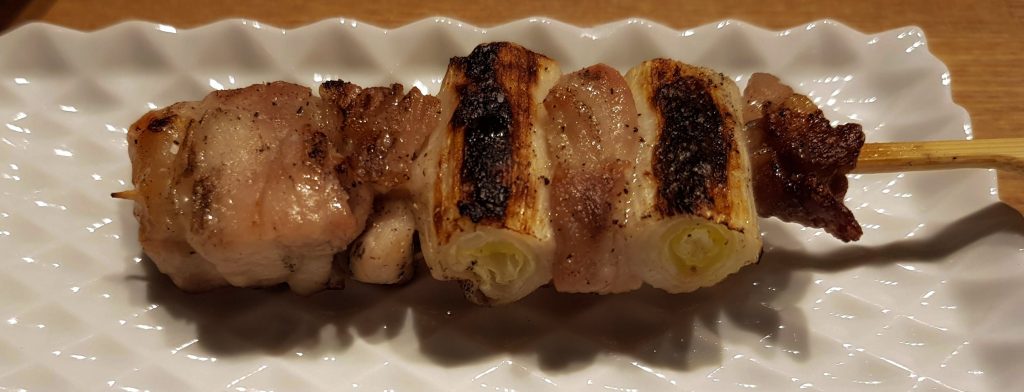
Kara age. (“aga” pronounced like the “a” of apple, then “gay”) This is basically deep-fried food, usually chicken. Kara age is a joy if you love your fried chicken. If you have a choice of sauces, BBQ is not like the BBQ sauce you’d expect and it’s delicious.
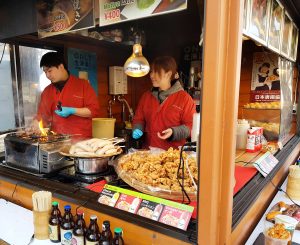
Kushikatsu. These are, simply, deep-fried sticks of meat, fish, vegetable and “other” coated in breadcrumbs. I love freshly cooked kushikatsu, albeit in a slightly guilty way because it really is possible to eat a lot of them as a “balanced” meal in a kushikatsu restaurant. Cheese kushikatsu is particularly lovely, as is gingko nut (in autumn), prawn and actually most vegetables.
Potato salad. Japanese potato salad is really good. It often comes with bacon. Sometimes cheese too. I mean, hello, potato, bacon and cheese?!

“Gobo” means burdock and a small dish of julienned burdock (a kind of grey brown) with carrot and soy sauce (and rice vinegar, etc) and sesame is a good flavour, very earthy and not at all like dandelion and burdock drink. Burdcock root is very good for you and sometimes I would order this to make myself feel better for all the fried dishes inevitably ordered.

Tonkatsu. Breaded, deep-fried pork cutlet. Quite often served cold in a bento, which works better than you might expect for cold deep-fried pork.
Yakisoba. Fried noodles with a slightly sweet sauce. Quick and easy dish, usually one portion being dinner plate-sized. The shredded pink bits are ginger root not fish paste as per previously-mentioned mysterious pink additions.
Bibimbap. A Korean dish, usually served in a hot bowl with meat, vegetable, a raw egg and rice. It’s sort of a Korean version of bubble and squeak, both being fairly random yet ending up tasting good. As soon as you are served bibimbap in a hot bowl, mix it all up so the egg cooks; serve straight away so it doesn’t all stick to the bottom. It tastes a lot nicer than it sounds or looks and the sauces etc taste good, usually a little bit spicy.

